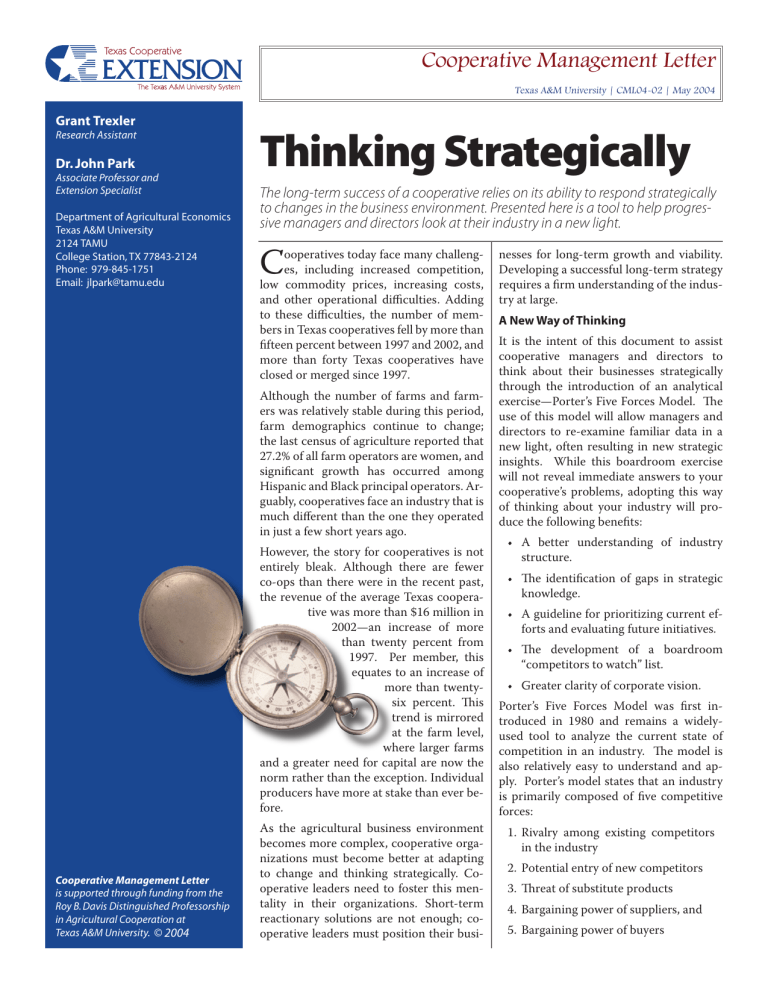Thinking Strategically Cooperative Management Letter

�������������
������������������
�������������
�����������������������
��������������������
������������������������������������
��������������������
���������
������������������������������
��������������������
�����������������������
�����������������������������
�������������������������������������
����������������������������������������
�������������������������������
��������������������� © 2004
Cooperative Management Letter
Texas A&M University | CML04-02 | May 2004
Thinking Strategically
The long-term success of a cooperative relies on its ability to respond strategically to changes in the business environment. Presented here is a tool to help progressive managers and directors look at their industry in a new light.
C ooperatives today face many challenges, including increased competition, low commodity prices, increasing costs, and other operational difficulties. Adding to these difficulties, the number of members in Texas cooperatives fell by more than fifteen percent between 1997 and 2002, and more than forty Texas cooperatives have closed or merged since 1997.
Although the number of farms and farmers was relatively stable during this period, farm demographics continue to change; the last census of agriculture reported that
27.2% of all farm operators are women, and significant growth has occurred among
Hispanic and Black principal operators. Arguably, cooperatives face an industry that is much different than the one they operated in just a few short years ago.
However, the story for cooperatives is not entirely bleak. Although there are fewer co-ops than there were in the recent past, the revenue of the average Texas cooperative was more than $16 million in
2002—an increase of more than twenty percent from
1997. Per member, this equates to an increase of more than twentysix percent. This trend is mirrored at the farm level, where larger farms and a greater need for capital are now the norm rather than the exception. Individual producers have more at stake than ever before.
As the agricultural business environment becomes more complex, cooperative organizations must become better at adapting to change and thinking strategically. Cooperative leaders need to foster this mentality in their organizations. Short-term reactionary solutions are not enough; cooperative leaders must position their businesses for long-term growth and viability.
Developing a successful long-term strategy requires a firm understanding of the industry at large.
A New Way of Thinking
It is the intent of this document to assist cooperative managers and directors to think about their businesses strategically through the introduction of an analytical exercise—Porter’s Five Forces Model. The use of this model will allow managers and directors to re-examine familiar data in a new light, often resulting in new strategic insights. While this boardroom exercise will not reveal immediate answers to your cooperative’s problems, adopting this way of thinking about your industry will produce the following benefits:
• A better understanding of industry structure.
• The identification of gaps in strategic knowledge.
• A guideline for prioritizing current efforts and evaluating future initiatives.
• The development of a boardroom
“competitors to watch” list.
• Greater clarity of corporate vision.
Porter’s Five Forces Model was first introduced in 1980 and remains a widelyused tool to analyze the current state of competition in an industry. The model is also relatively easy to understand and apply. Porter’s model states that an industry is primarily composed of five competitive forces:
1. Rivalry among existing competitors in the industry
2. Potential entry of new competitors
3. Threat of substitute products
4. Bargaining power of suppliers, and
5. Bargaining power of buyers
Rivalry
It is the nature of competition that firms will strive for advantage over their rivals. As such, rivalry is typically the strongest of the five competitive forces in any given industry. It can be defined as the competition that goes on between firms as they try to increase their market share. For example, this can be viewed as the competition that the co-op faces when members look elsewhere to gin their cotton, sell their products, or purchase their supplies. Due to the nature of agricultural commodities, this rivalry usually focuses on price competition, with firms attempting to provide the lowest price possible for farm inputs and the highest price possible for farm outputs.
This reveals one of the many challenges of cooperative management, rivalry on more than one front. Many cooperatives find themselves competing for the sale of outputs in addition to competing for the participation of their member-owners.
Some cooperatives have a supply relationship with their members, some have a customer relationship with their members, and some have both. Needless to say, cooperative management is a complex task requiring complex strategy and direction to support it.
What is the best strategy for a cooperative business to use in order to provide it with a competitive edge over its rivals? Each firm’s strategy is dependent upon the strategies of rival firms and the willingness and ability of all firms to put resources behind their efforts. Although rivalry is dynamic and ever-changing, several common factors influence competitive rivalry:
• Rivalry is usually stronger when product demand is growing slowly.
• Rivalry is more intense in industries that have high fixed costs. These conditions tempt competitors to use price cuts or other competitive weapons to boost unit volume to cover these costs.
����������
�����
���
�
�
��
���
��
�
��
�
���
���
��
��
��
��
���
��
��
���
��
��
�
�������
��
���
��
��
��
����
����
�����
�������
�����
���
����
���
��
��
��
��
��
��
Porter’s 5 Forces Model can help to sort through the whirlwind of pressures affecting your industry, allowing you to strategically position your business to succeed.
Your Turn…
Cooperative Management Letter | May 2004 | 2
• Rivalry is stronger when the customer’s cost to switch
“brands” is low.
• Rivalry tends to be stronger when it costs more to get out of a business than to stay in and compete.
• Rivalry becomes more volatile and unpredictable with more diverse competitors in terms of their objectives, strategies, resources, and countries of origin.
• Rivalry is stronger where there is low product differentiation.
• How intense is the rivalry faced by your cooperative?
• List your immediate competitors and ask yourself what advantages or disadvantages these businesses have compared to your business.
The Potential for New Competitors
New entrants into a market bring new production capacity, the desire to gain a foothold in the market, and sometimes, substantial resources with which to compete. These new competitors may come from several sources: market areas or segments you currently do not serve, indirect competitors with competing products (covered in the next section), customers, and suppliers. The potential for the entrance of new competitors into a market is principally dependent upon barriers to entry and the expected reaction of the incumbent firms. Barriers to market entry include: economies of scale, brand preferences and customer loyalty, capital requirements, and government policies such as tariffs and trade restrictions and regulatory policies.
Whether these barriers are judged as high or low depends, in part, on the resources and competencies of the potential new entrants.
In agricultural markets, the largest threat for new entrants comes from foreign producers entering the U.S. and World markets. For example, the development of produce and vegetable production in Central and South America has changed the U.S. market for fresh foods.
Your Turn…
• Is there growth and profit potential in your industry that would attract new entrants?
• List any barriers that make it difficult to enter your industry what it would take to overcome these barriers.
• Is it possible for your customers or suppliers to replace you with business initiatives of their own?
The Threat of Substitute Products
In context of this analysis, substitute products are products in other industries that can potentially affect the demand for your own product (“product” should be interpreted to include services as appropriate). In general, the more substitute products that are available to the customer, the more difficult it becomes for firms to raise their prices. The degree of difficulty will depend on how easily one product is substituted for another in the mind of the customer.
Cooperative Management Letter | May 2004 | 3
Thus, the strength of competitive pressures from substitute products is dependent upon three factors: 1) whether substitute products are attractively priced and available; 2) whether or not buyers view the substitutes as comparable when analyzing price, quality, performance and other attributes; and 3) whether buyers can easily switch to substitutes. For example, cotton producers are in head-on competition with the makers of polyester fibers.
Competitive pressure from this cotton substitute will increase as the price of polyester relative to cotton decreases, its characteristics are improved to match the more desirable characteristics of cotton, and the user’s cost of switching from one product to the other is lowered. Unfortunately, in agriculture, many products are viewed as commodities with little brand distinction and low switching costs.
Your Turn…
• List your cooperative’s products and services alongside substitute products and services.
• How closely are these products and services substituted for one another?
• Is there anything you can do to: 1) make it more difficult for customers to switch products to a substitute, or 2) differentiate your products and services (say through the addition of new features or characteristics), making them less comparable?
Your Turn…
• List your major suppliers and consider their importance to your business.
• Are you a significant customer of these suppliers?
• Are there ways you can lessen their strength through finding alternative suppliers or strengthening collaborative efforts?
The Bargaining Power of Buyers
Whether the bargaining power of your customers is weak or strong can be evaluated in a similar manner as supplier bargaining power. Even if buyers do not purchase in large quantities or offer a seller important market exposure or prestige, they may still have some degree of bargaining leverage if: 1) the cost of switching to an alternative product is low, 2) they can credibly threaten to integrate backwards into the business of the seller, or 3) they have discretion as to whether or when they purchase.
Buyers typically have weak bargaining power when they purchase infrequently, buy in small quantities, or when they face high costs to switch brands.
Your Turn…
• Consider your customers (they may be your ownermembers!) and the importance of your business in their lives.
• Are there ways your cooperative can play a more prominent role in their business decisions (e.g. through added services, products, or loyalty initiatives)?
• Alternatively, is your business dependent upon a few large customers? How can you decrease this dependence?
The Bargaining Power of Suppliers
Your business is dependent upon certain suppliers that provide labor, materials, and other components. Competitive pressure from these suppliers is strong when they can exercise sufficient bargaining power to influence the terms and conditions of exchange in their favor. This pressure is further strengthened when suppliers are concentrated. In agriculture, producers typically are seen as having little bargaining power or leverage due to the number of sellers in the open market. Likewise, cooperatives face this dilemma on a daily basis. It is relatively easy for farmers to obtain what they need from several different suppliers as well as market their products through several different channels of distribution.
Your suppliers have a weak bargaining power when close substitutes for their goods or services are available, and it is neither costly nor difficult to change suppliers. Suppliers also have less power over your pricing and terms of sale when your firm is a significant customer and the loss of your business would have serious negative effects. Similarly, customers may be at the mercy of a supplier if the supplier controls the market enabling the supplier to exert pricing power.
Collaboration with your suppliers can translate into a competitive advantage in the market. In many industries, sellers are signing long-term strategic agreements with select suppliers to: improve inventory efficiency and reduce costs, “lock-in” specific quality standards, improve delivery and reliability of products, and tap the potential for higher profits in the marketplace.
It’s a Journey, Not a Destination
The five forces model is a tool. It is a tool that can be used to measure the level of competition in your industry and potential threats to your profitability. Generally, the stronger the impact of the competitive forces, the lower the profitability of the participant firms. Once cooperative leaders understand these competitive forces, they gain the insight needed for strategic direction.
The five forces model is also a dynamic tool. It is a tool that needs to be continuously updated as the world around us changes. Managers and directors must be aware of political, economic, and social trends that affect their cooperative, its business, its members, and the industry, in order to respond in a profitable way. Judicious use of the Five Forces model will enable the modern cooperative to build a legacy that will reward its members and provide a sustainable competitive advantage.
Educational programs of Texas Cooperative Extension are open to all people without regard to race, color, sex, disability, religion, age, or national origin.
Issued in furtherance of Cooperative Extension Work in Agriculture and Home Economics, Acts of Congress of May 8, 1914, as amended, and June 30, 1914, in cooperation with the
United States Department of Agriculture, Chester P. Fehlis, Deputy Director, Texas Cooperative Extension, The Texas A&M University System.






